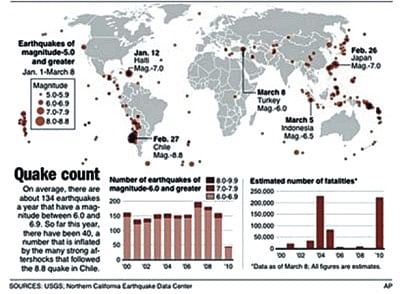What caused the recent quakes?

Lately the Earth has been quite active as far as her seismic behaviour is concerned. Let's have a look at the recent earthquakes since the beginning of this year. On January 12th, a magnitude-7.0 quake devastated Haiti and on February 27th, a 8.8-magnitude tremor hit Chile, shifting her largest city, Concepcion, at least 10 feet to the west! And a similar earthquake struck Japan on February the 26th, thankfully causing less damage. Then again on March 4th, a magnitude of 6.4 quake hit Taiwan followed by a 6.5 one on the very next day in Indonesia. And on March 8th a pre-dawn 5.9 magnitude earthquake rocked south-eastern part of Turkey. The recent surge in the frequency as well as intensity of the quakes, a calamity that comes out of the blue, has sent leading experts in the field worrying. However, the string of quakes over the last three months might well be a matter of mere coincidence. Prof. Bob Holdsworth, an expert on tectonics at Durham University, England says, "I can definitely tell you that the world is not coming to an end". It is important to note that according US Geological Survey, on average there are 134 earthquakes a year that have a magnitude between 6.0 and 6.9. And this year experienced a hasty start, with 40 of such so far, more than in most years for that particular time period. But there is no geological connection between these recent earthquakes as these tragic natural events involved different tectonic plates.
The recent quakes that shook different continents have razed city after city killing and dislodging hundreds of thousands of people. With the passage of time, more and more people are building their homes in mega-cities and constantly putting up substandard urban infrastructures that cannot withstand earthquakes. Dr. David Rothery, a planetary scientist with the Open University, UK, explains that even though proximity of the epicenter to the affected area is a major factor along with the character of the soil, the decisive factor in determining the extent of the devastation chiefly depends on the construction standards and density of the population. In the words of Dr. John Mutter, a seismologist and a disaster expert at Columbia University, "Earthquakes don't kill people, bad buildings kill them". This truly explains the massive death toll (around 200,000) and the destruction caused by the Haiti quake even though it had the same severity as the 1989's San Francisco earthquake which killed only 63 people. A recent World Health Organization data shows that more than 453,000 people have died from earthquakes from the year 2000 to 2009, a marked rise compared to the previous two decades. According to University of Miami Geologist, Prof. Tim Dixon, it is the Haiti quake that is likely to set a modern record for deaths per magnitude of earth "solely as a function of too many people crammed into a city that wasn't meant to have that many people". It certainly makes you wonder about the risk Bangladesh and, especially, its overpopulated capital city is dangerously exposed to.
Dr. Kurt Frankel of Georgia Institute of Technology explains that since the quakes occurred one after another, and earthquake being on people's mind, so many occurring early this year somewhat skewed the picture. But truthfully, even though earthquakes can trigger other seismic activities, the recent tragedies in those aforementioned events are in fact too far apart in respect of both time and distance to be connected.
.............................................................
The contributor is a freelance science writer.

 For all latest news, follow The Daily Star's Google News channel.
For all latest news, follow The Daily Star's Google News channel. 



Comments